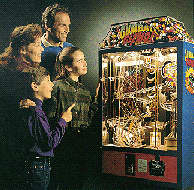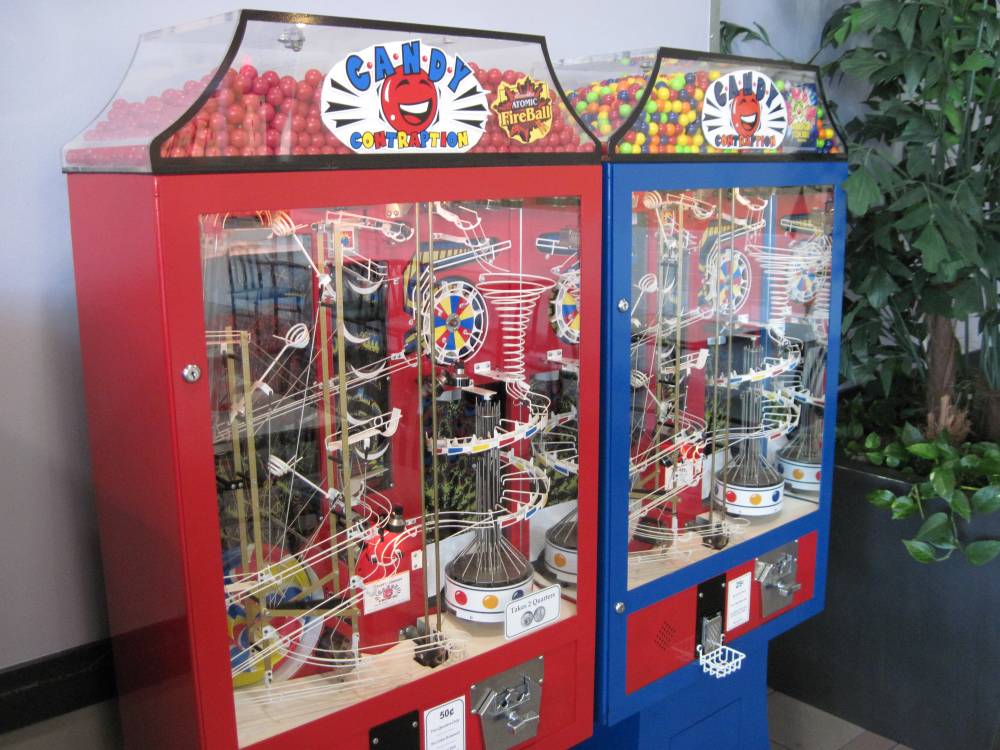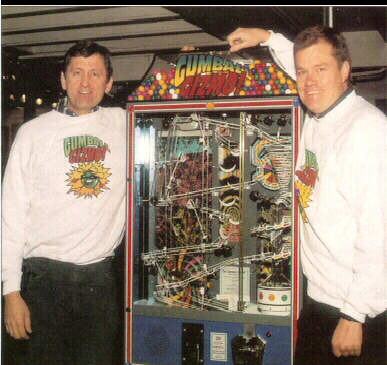|
|
|


Specifications:
Height: 5' 8"
Depth: 12 inches
Weight: 270 Lbs.
Window display: 25" x 28"
Base: 2.5 ft. sq. floor space
Capacity: Approx. 2000 gumballs, 1430 Ct.
Coin requirements: Uses Northwestern Model 80 coin mech, configurable
to any coin.
Internal lighting: 3 systems:
5 lamps, 1 spotlight always on
9 front-mounted spotlights, digitally controlled
6 back-mounted lamps, digitally controlled
Gumball Gizmo is microprocessor-controlled, has 9 DC motors. It supports multiple vends, (with all the gumballs going every which way inside simultaneously), as well as internally-incremented count of coins entered up to 256 coins.
The Gumball Gizmo was conceived by Dale Emery and Van Peery of Utah in 1991. After three years of working part-time, the prototype debuted in Trolley Square on September 23, 1993. There is still a Gumball Gizmo there, right beside the "Kineticon." The Gizmo was an instant success. It appeals to everyone, and is a more fun way of enjoying a gumball. A brief description of what it does:
Update 5/97 Gumball Gizmo is getting a new voice, on selected units. All sounds were homemade and home-synthesized! The sound system uses time-coded segments linked to the microprocessor codes generated during normal play. Sounds are recorded analog on an Information Storage Devices chip.
Here are a few of the sounds: (Late-model versions of Netscape or Internet Explorer required. Or try downloading as-is and playing back as .wav files.)
Following is a reprint of an article which originally appeared in
the "Morris Air Traveler" In-Flight magazine: (Morris Airlines was purchased
by Southwest Air some years ago.)
"Gumballs Go Hi-Tech" by Tabb George

As we move into the 21st century, modern society's almost insatiable appetite for higher technology has presented us with the information superhighway. Following in the footsteps of this vast computerized world is a new way to satisfy our never ending appetite for gumballs-the "Gumball Gizmo."
Those old round gumball machines offer brightly-colored balls that are usually fresh, but a disproportionate number of white ones seem to keep appearing no matter how you shake the machine. Even the most liberal gumball chewers cannot help being irked, even though it is only spent pennies.
Now, the overgrown offspring of those original gumball machines tower over us as we hustle our children through the corridors of our favorite shopping malls. These megamachines are stretching reality just a bit. They dispense a sumo gumball big enough to choke a hippo, but somehow our children manage to wrap their lips around those units. If that weren't enough, their teeth then have to cut through the outer protective crust, which has been aged at least as long as a fine California Chardonnay, and then chew a wad that would make Lenny Dykstra of the Phillies proud.
After spending a whole quarter on this hunk of potential drain clog, it's no wonder parents break for the nearest exit when kids point to those "bigmouth" balls.
Dale Emery and Van Peery think it is about time they change the course of gumball machines forever. Their company, Bixworks, has invented a marvelous new way to combine entertainment with vending. The "Gumball Gizmo" vends enticing normal-sized gumballs, and exploits the fascination we all have for contraptions which put on a show. And what a show it is. Forty-five seconds is all the time it takes each colored gumball to exit its trapdoor atop the "gizmo" and perform a series of amazing stunts until it hits the exit. During some phases of the journey, the ball almost moves too quickly to follow. Over the "Cascade Lift" and other trademark devices, the ball is handled with such precision that you would think NASA built it as a kind of "spherical propulsion" experiment.
If you want to be amused the next time you are in Salt Lake City's Trolley Square, go to the Spaghetti Factory on the second level and watch the reactions of people who stand and watch the "Gizmo" work. Emery and Peery never seem to grow tired of it. Reaction of patrons vary from a daze-like stupor to spontaneous applause. Of course, the kids, even after they are pried away and promised a return visit, are instant fans. But, parents usually go away from the "Gizmo" feeling a little better for having provided a lot more than just a gumball. "It brings out the 'little kid' in just about everyone," says Emery. "Because the appeal is fueled by impulse, it's more the rule that people can't bear to see the action just one time."
Out of this "synthesis of an idea," as Emery calls it, has emerged a golden business opportunity. If things go as planned, Bixworks will soon be running at full speed to keep up with the market demand from restaurants, malls, airports, museums, and even theme parks. In its first twelve weeks of operation the prototype exceeded all revenue projections. The record revenue for a single day in the "Gizmo's" first six weeks of life is $120, matching the "Gizmo's" preliminary monthly earning estimates. With plans for 10 new machines now in production, Bixworks is on schedule to meet short-term objectives and bring in new capital.
This kind of gumball magic isn't the result of an imaginative stab in the dark. The "Gizmo" is the result of years of disciplined work by Emery and Peery to craft and perfect a kinetic machine that appeals to all age groups. The "Gizmo's" predecessor, the "Kineticon," was the first step toward realizing a tangible result.
Since its completion in 1979, the "Kineticon's" complex coin-driven mechanical show has captivated thousands of people. For the last five years, it has become a well-known fixture across from where the "Gizmo" now appears. Although the appeal and durability of the "Kineticon" has been proven over the years, the fact that it doesn't vend a product limits its financial viability. However, the knowledge Emery gained from crafting the "Kineticon" proved to be invaluable in creating the "Gumball Gizmo."
After four years and an investment of $25,000, each minute detail of the "Gizmo" has been thoroughly researched and crafted. Utilizing whatever time they had after work, Emery and Peery smoothed out the complexities of prototyping each phase of the overall concept. With over 20 years of experience creating, building, refurbishing and maintaining coin-operated machines between them, Emery and Peery have formed a unique synergy. Emery explains that they started with a "blank canvas," which reflects his artistic approach to the technology. Peery brings a broad manufacturing expertise to the partnership. "One idea seems to evolve into realistic possibilities with fundamental solutions," explains Peery. "I can come up with a hair-brained idea that Dale really takes off on. I built a crude prototype of the 'Cascade Lift,' one of the most complex phases of the 'Gizmo,' but Dale saw that it worked efficiently and he perfected it from there." Emery sums their creative energy by saying that most of their results come from "a combination of serendipity and just tinkering around."
The light sensors and overall dynamics of the "Gizmo" are orchestrated by a microprocessor, the same technology which runs pinball machines, state-of-the-art automobile dash boards, heating and air-conditioning and all kinds of medical equipment. Precision-crafted internal parts are made of brass in combination with steel wire parts which are plated and powder-coated to insure that the gumballs don't pick up unwanted residue on the way to your hand.
Emery's artistic-techno flair shows up in the "Gizmo's" graphics. The normal everyday gumball fan, if he/she even cares, might assume the graphics are just random brush strokes. But, if physics students look closely at the design, they might be surprised to see a "bubble chamber" image of a high energy neutrino striking a hydrogen nucleus. Say again? And, not coincidentally, computer-generated "fractal" imagery just pops right out of the background in another section. Emery modestly mentioned that he created all the graphics on his IBM compatible PC.
Until now, the focus for Bixworks has always been art first, gumballs second. But, in order to get production to the next level, the pace has to quicken. "Having had the luxury of not rushing into the project and creating immediate pressure for ourselves has been a great asset," says Emery. "Now that we have a technological edge, we can move faster and enjoy the strong base we've developed."
The future looks busy, but tremendously satisfying for Bixworks. Emery, Peery and their creative partners have a unique business savvy to go along with their technical knowledge. Their production schedule is comprehensive. Fifty percent of the parts for the 10 new "Gizmo" machines are already manufactured. Peery's two oldest sons have become immersed in the project and know the production specifications almost by heart. The work has delayed Emery's Fine Arts degree at the University of Utah, but he doesn't mind the detour. "It's all part of the master plan," Emery says. "I'm working at it full time and, maybe by the end of the year Van will be able to devote full-time as well."
There is no end to the spin-off ideas. Theme parks would be ideal location for interactive coin-operated machines which would simulate all kinds of environments. "Interactive machines that tap into the music-orientation most people are attracted to is one of my dreams," Peery says with a look of confidence. If someone else said that you might be skeptical. But with Peery and Emery, practically anything they envision seems possible.
To some this might seem like a lot of fuss for a gumball machine. But,
to those who like to dabble a little in imaginative thinking, the "Gumball
Gizmo" is a classic example of what can happen when imagination comes to
life. What else wold you expect from the 21st century? If you would like
more information about the "Gumball Gizmo" call Dale Emery at Bixworks
at (number deleted).
Vending machines are typically pretty unimaginative: You put some money in and, if you're lucky, some junk food comes out.
But Van Peery and Dale Emery have an idea they hope will revolutionize the whole business. It's the vending machine as entertainment: Put some money in and watch your junk food take a fantastic voyage before it reaches its destination.
Their first machine is the Gumball Gizmo, a contraption that takes a piece of bubble gum on a 45-second Rube Goldbergian odyssey. A prototype has been at Trolley Square since October1993. Now Peery and Emery are ready to go nationwide.
At Bixworks, their small manufacturing plant in Lehi, they're busy assembling mass-produced versions of the frenetic gumball machine, which will be distributed by a company in Wisconsin.
The inventors will deliver their first machines this fall. Within a year, says Emery, Bixworks hopes to be producing about 100 Gumball Gizmos a month. The Gizmo sends an orb of bubblegum on a mechanical adventure around spirals and ramps, through trap doors and down a moving staircase. The ride costs a quarter, and although you only get about a dime's worth of gum, the Gizmo's inventors say the average gum chewer is willing to pay the extra change, and spend the extra time, for the chance to watch the gumball make its wacky journey.
"People love to be entertained and a quarter isn't too much," says Emery, who adds that the Trolley Square Gumball Gizmo grosses about $1,000 a month, compared to about $90 a year for a standard vending machine.
Both Emery and Peery have been inventing and building one thing or another since they were kids, although they didn't always have the money to follow through (Peery thought of an idea very much like Roller Blades 40 years ago when he was a farm boy in Spring Lake, Utah.)
Emery built a precursor to the Gumball Gizmo when he was a teenager in Erie, Pa. his "Kineticon"-which he kept under a sheet at first so his family wouldn't make fun of it-included a toy train, a fountain and traveling marbles. In 1983, Emery showed the contraption to Peery, operations manager at Trolley Square, who installed the machine and also offered Emery a job. Emery later worked as an engineer's technician at the University of Utah's Center for Engineering Design, building robots and micromotors.
Emery and Peery built the original Gumball Gizmo in their garages in
their spare time. Their next project is Gumball Gizmo II. But "the gumball
machine is only the start," says Peery. The inventors have a half dozen
more designs for kinetic vending machines and kinetic art. Coming soon,
they hope, to a mall near you.
The graphics work, including the Gumball Gizmo logo, "Gizmo" character,
as well as all screen process printing, by The Graphic Shop, Salt
Lake City, Utah. (801) 466-2955